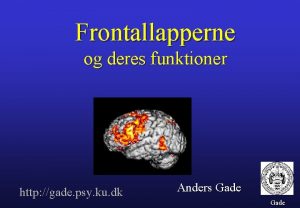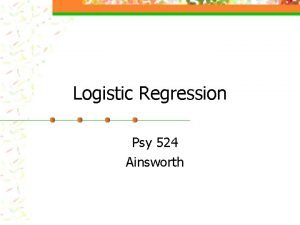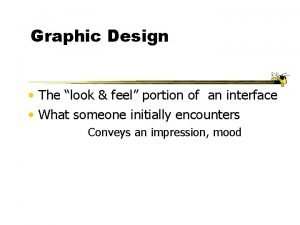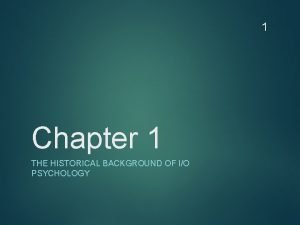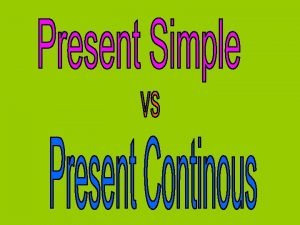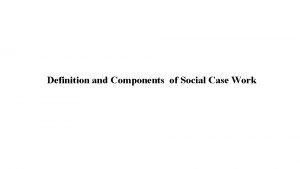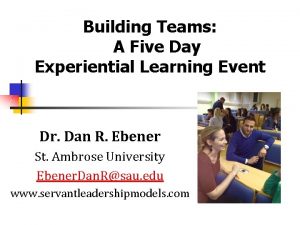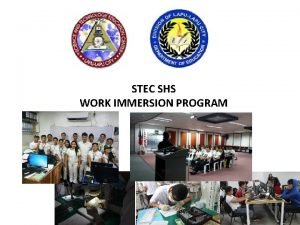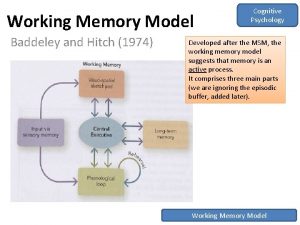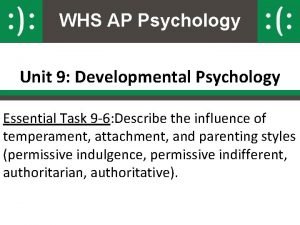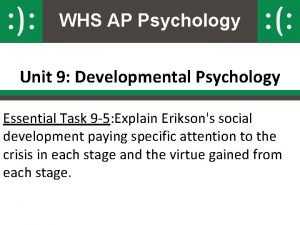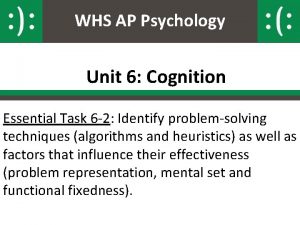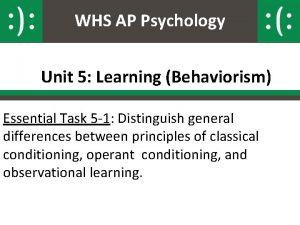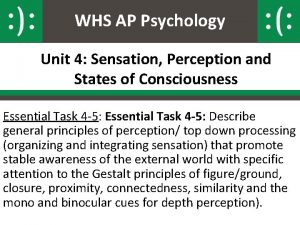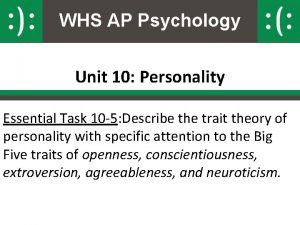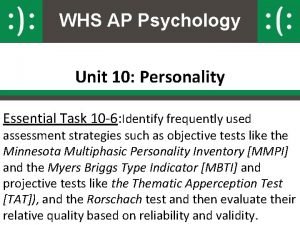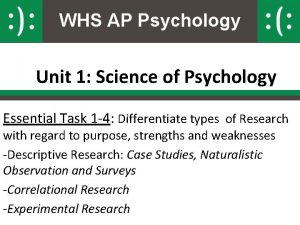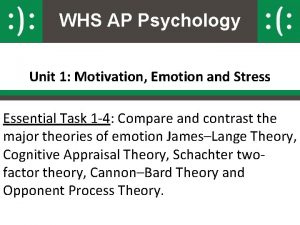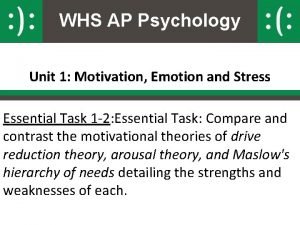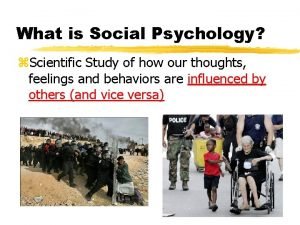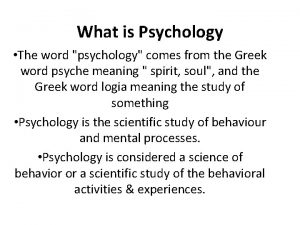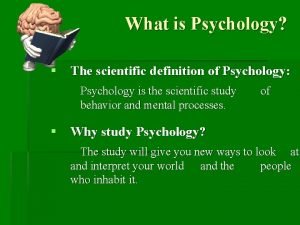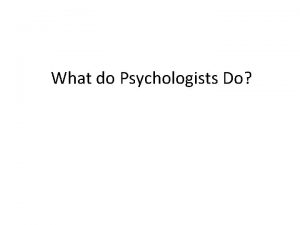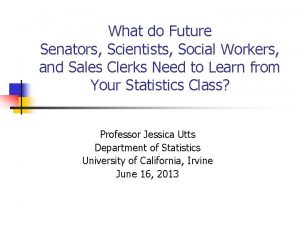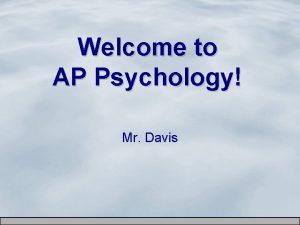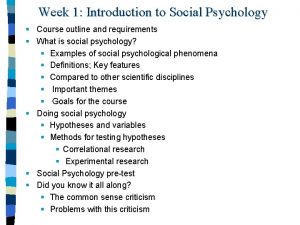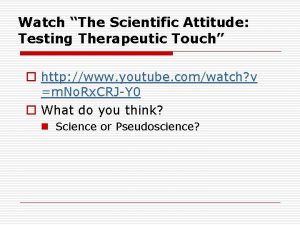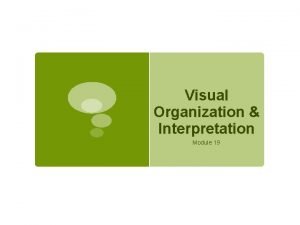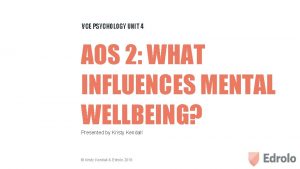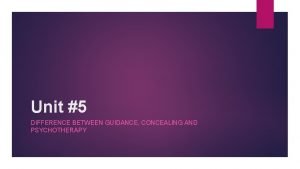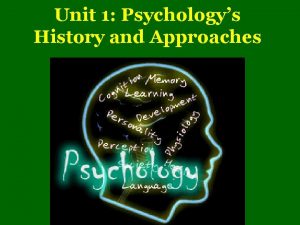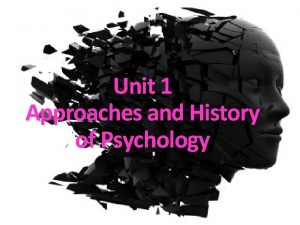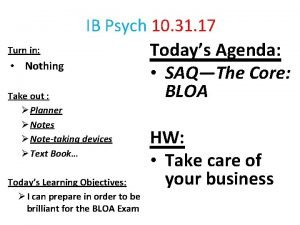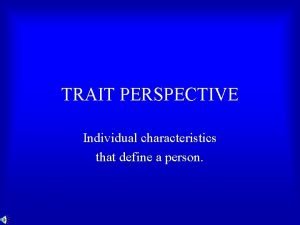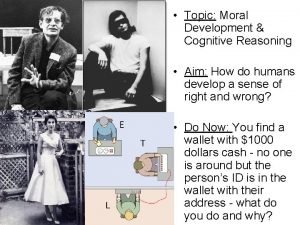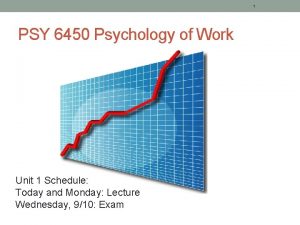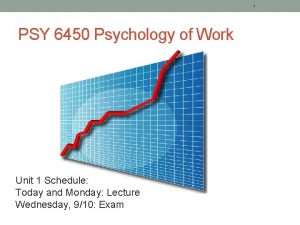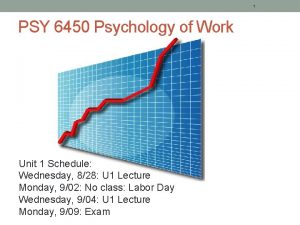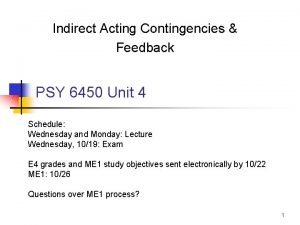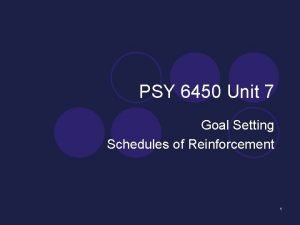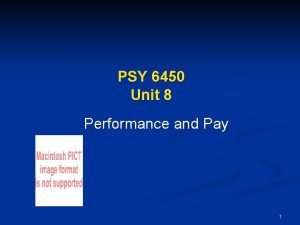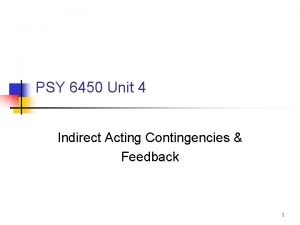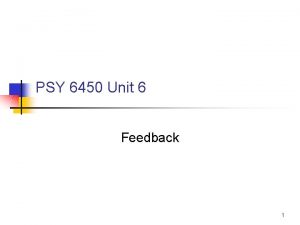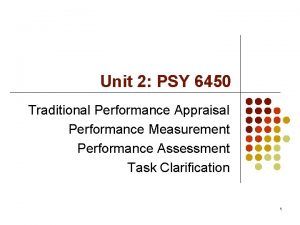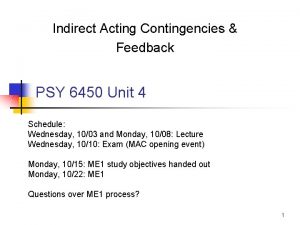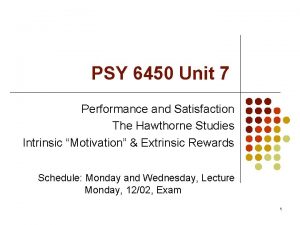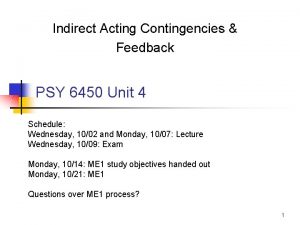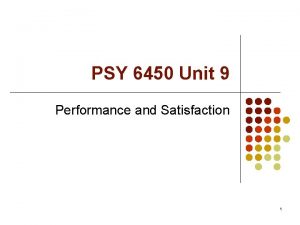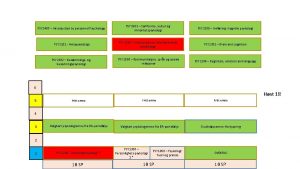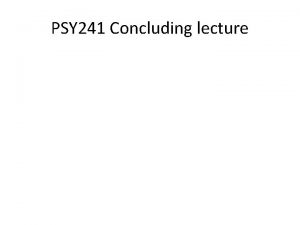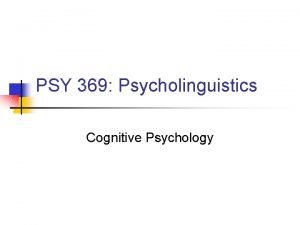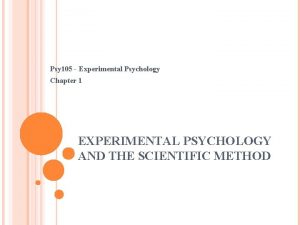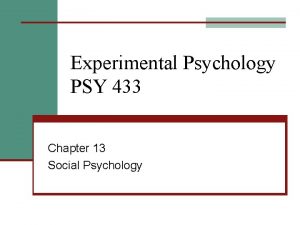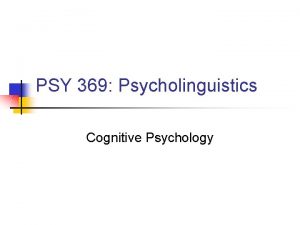PSY 6450 Psychology of Work 1 PSY 6450













































































- Slides: 77

PSY 6450 Psychology of Work 1

PSY 6450 Unit 1 Schedule • Today and Monday: Lecture • Wednesday, 9/11: Exam 2

PSY 6450 Unit 1 • Some facts and a little history of I/O – Aamodt • Differences between I/O psychology and OBM – Bucklin et al. (2000) – Written essential material into SOs • History of OBM – Dickinson (2000) – 20 th anniversary issue of JOBM 3

SO 1: I/O vs. Business Fields, #1 • The application of psychological principles distinguishes I/O from related business fields – HRM texts advocate using unstructured interviews for selection; I/O has shown these are much less effective than other methods – Business advocates the use of Myers-Briggs to select and coach employees; I/O does not – Business advocates the use of “stretch” goals; I/O does not – Business advocates EOM programs; I/O does not (2 differences and explain each, giving examples; little hard to abstract out) 4

SO 1: Daniels’ Oops: 13 management practices that waste time and money 1. Employee of the month programs (and most other forms of reward and recognition programs; winners/losers) 2. Stretch goals 3. Performance appraisal 4. Ranking employees 5. Rewarding things a dead man can do 6. Salary & hourly pay (no accidents, no errors, be at your workstation) 5 7. You did a good job, but… 8. The sandwich method of providing feedback (good, bad, good) 9. Overvaluing smart, talented people 10. The budget process 11. Promoting people no one likes 12. Downsizing 13. Mergers, acquisitions (Enron, JPMorgan, 5. 8 billion trading/investment)

SO 1: I/O vs. Business Fields, #2 • I/O focuses on factors that affect the people; business focuses on factors that affect running a business* – Business courses: accounting, finance, marketing, business law, corporate policy, – Psychology courses: training and development, selection and placement, systems analysis, experimental methodology (permitting evaluation of interventions) *However, there is clearly overlap: Psychology of work vs. organizational behavior and management; systems analysis vs. business process management and supply chain management, for example. 6 (recommend that all of our students take accounting)

Four basic areas of I/O psychology* (NFE) • Personnel Selection and Placement – Main area of emphasis for I/O – Not emphasized in OBM • Training and Instructional Design – Largest area of employment for MAs • Performance Management – Focus of this course • Systems Analysis - Organizational Development *these differ from Aamdot’s list: his are more general (Note: not counseling or clinical. EAP programs - counseling/clinical/social work degrees; recent health and wellness programs - yes) 7

SO 3: The I and O in I/O Psychology • Industrial – Focuses on the individual worker/position • Determining the requirements of each job/position • Selecting individuals who have those requirements • Training individuals to improve their competency • Organizational – Any aspect of the organization and structure that affects performance and/or satisfaction • Reward/pay systems • Feedback systems • Organizational structure (systems analysis) (distinction that has little relevance today, overlap between the two, but remains in the name) 8

Some I/O history: First area of application • SO 4 A: The oldest area of application and the one that still dominates today is Personnel Selection & Placement. – Main difference between I/O programs and OBM programs. • SO 4 B: Personnel Selection got started by selection and placement of military personnel in WWI & WWII – Clinical tests, typically intelligence and personality tests, and used them to test recruits (emphasis influences other aspects of training - statistical methods used to determine reliability and validity of tests - job relatedness; SO 8 – Aamodt, at least 5 stats courses in PH. D. IO) 9

SO 5: Putting the “O” in I/O psychology • One of the greatest episodes in the formation of I/O according to many: Hawthorne Studies in the 1930 s – Heretofore restricted to personnel issues such as selection and training (the I in I/O) – Expanded to: • Human relations • Quality of work environment • Attitudes – Satisfaction and group morale 10

SO 6: Personnel Selection (NFE) • I/O expanded greatly when Congress passed Title VII Civil Rights Act, 1964 – Banned unfair discrimination against minorities and females • I/O has a “lock” on personnel selection as a profession Other EEO Laws: • Age Discrimination • Vietnam/Disabled Veterans • Americans with Disabilities Act (overlap between I/O and OBM and other areas: mgt – 0% MBA programs, human resources, Industrial engineer - selection remains I/O. don’t deal with laws and issues here, personnel selection) 11

SO 9: Where do I/O psychologists work? • 10 A: Ph. D. s (learn top three for exam) – Higher education – Consulting firms – Private Industry – Public Government 40% 25% 24% 8% • 10 B: MAs (learn top two for exam) – Private Industry – Consulting firms – Public Government – Higher education 44% 37% 11% <1% (note difference Ph. D universities vs. industry; difference MA, private, more likely to work in private business with MA; consulting firms, interesting data 12

SO 10: $$ Salaries - SIOP Survey 2012 (NFE) Median Starting Median Overall Male Median Female Median $120, 000 $103, 000 Ph. D $78, 000 $118, 000 MA $64, 000 $82, 500 $ Ph. D median starting same for applied & profs $ Profs significantly lower than applied $ Female median is 15% lower than males but first significant decrease-and least since-1982! (High starting salary for MAs - $40 -$50 K; last pertains to Ph. D&MA combined; mean salaries 20% lower; about 50% of students are now female; 14% when I got my IO degree in 1977; WMU figures in Sos; expt inst. ranks lower; fulls paid 12% less than males; Differences are less than in the past; university has gender equity committees looking into this/reduce it. Dr. Baker & Fuqua) 13

Facts about I/O psychology • SO 11: Primary professional organization for I/O psychology Society for Industrial/Organizational Psychology Web site: www. siop. org Also, SIOP is Division 14 of APA (Behavior Analysis is Division 25) 14

Facts about I/O psychology • SO 12: Primary journal for I/O psychology (NFE) Journal of Applied Psychology Note list of 22 journals in Table 1. 5 JOBM is not included (little cross-fertilization between IO psychology and OBM: At this point in time most OBM practitioners/students don’t know much about IO and vice versa 2011 special issue of JOBM devoted to integration; well worth reading) 15

Facts about I/O psychology • SO 13: Percentage of Ph. D psychologists who are I/O psychologists 4% 50% of APA’s 96, 000 psychologists are clinical, counseling and school psychologists Thus, it’s not surprising that people don’t know about us 16

SO 14: Growth of IO (nfe) Year # of IO psychologists 1939 100 1960 760 1991 3, 000 2008 7, 500 Year MA programs Ph. D programs 1986 23 44 2008 75 65 (I graduated in 1977 with my MA degree in IO) 17

SO 15: Licensing of IO Psychologists (this slide NFE) • Very different than clinical psychology • Varies from state to state – Some require it, most don’t • Some states preclude it - i. e. , MI – Educational and experiential requirements focus on clinical/counseling courses and internships • Academics (who do not practice) do not have to be licensed (next few sos, licensing in IO psychology, and certification/licensing in BA) 18

SO 15: SIOP opposes licensing - why? • SIOP maintains that I/O psychologists – Should be able to be licensed – But should not be required to be licensed • Main reason why licensing is not needed – Licensing is designed to protect the public in health care areas (mental and behavioral health). I/O psychologists are not health care providers and do not deal with vulnerable populations. – Same argument OBM practitioners are making about license laws for behavior analysts • SIOP successfully blocked many states from passing license laws ~10 years ago (click no, licensing originally to protect public - vulnerable populations, health care areas Next slide, certification/licensing of behavior analysts) 19

SO 16: Certification vs. Licensing, Behavior Analysts • Certification is voluntary, licensing is legally required • The Behavior Analysis Certification Board (BACB) certifies behavior analysts at the national level – Because of this, certification requirements are the same for every state in the country • Individual states pass license laws – Because of this, the laws vary from state to state (independent from ABAI; compliance overseen by licensing boards established by the state; Legal penalties for violating license laws )20

Certification vs. Licensing of BA • National certification began in 1998 • Licensing began only recently – 10 states now have licensing laws for behavior analysts – Laws are pending in 9 states – A MI law is currently being drafted – In most states, if you are certified, you qualify for licensing (it’s hard at this point to separate certification and licensing, but they are still separate) 21

Certification of Behavior Analysts • Primarily relevant for those who work in human services (autistic and developmentallydisabled clients) – Protection of at-risk individuals – Many states require providers of behavioral services to be certified (or licensed) to receive insurance reimbursement • Thus, almost all human service organizations that provide behavioral services require employees to be certified to be hired – Particularly MA and Ph. D. level 22

Certification of Behavior Analysts • At this point, direct care staff and technicians do not have to be certified, but the BACB is initiating a new credential: Registered Behavioral Technician 23

SO 17: OBM and Certification • Most individuals in OBM are not certified – Do not deal with at-risk individuals – Our clients in business and industry do not require it – no money or insurance reimbursement is at stake – The current certification process, particularly the exam, is not very relevant for those in OBM • Exam, for the most part, focuses on applied behavior analysis with at-risk individuals • Different skills are required by those who work in OBM (not functional assessments, preference assessments; feedback, goal setting, management reward systems, systems analysis; BACB did reach out to OBM a long time ago, and again recently– not sufficient interest/market from folks in OBM to make it cost-effective) 24

OBM and Certification • Individuals in OBM can become certified – Coursework in WMU’s graduate program meets the educational requirement – Can count work in OBM toward the experience requirements • However, none of the WMU OBM faculty are certified, thus we cannot supervise those hours according to the new certification requirements 25

SO 18: Two reasons for BA license laws • To protect at-risk individuals – Push for licensing came from behavior analysts who work with at-risk individuals – Association of Professional Behavior Analysts • Promote and advocate for BACBs • Different than ABAI, but many individuals belong to both if they work with at-risk individuals • States began to pass autism insurance laws to cover ABA services – Needed a way to determine who was competent to provide those services and thus who could receive insurance reimbursement (only cover applied behavior analysts – not nonhuman operant or human operant – same reasons as for certification) 26

SO 19: Two main types of laws • Broad title and practice laws You cannot call yourself a behavior analyst or practice behavior analysis unless you are licensed – Five states have passed this type of law • Arizona, Kentucky, Massachusetts, Missouri, and Virginia (the wording of the laws do differ and others might object to my categories, but I am attempting to give you a broad overview – things are complicated right now) 27

SO 19: Two main types of laws • Restrictive laws Only behavior analysts who provide services to autistic children or to individuals with pervasive behavioral disabilities need to be licensed – Four states have passed this type of law • Nevada, North Dakota, Pennsylvania, Rhode Island – Michigan’s draft law restricts licensing to behavior analysts who provide clinical services • I expect further revisions before it is finalized 28

Other types of laws & state regulations • Title license law: Wisconsin – You can practice behavior analysis without a license but you cannot call yourself a behavior analyst • Regulations tied to insurance autism laws (often written into insurance laws) – Autism service providers must be certified to receive insurance reimbursement – 16 states have these type of regulations • I don’t know how many are considering license laws • West Virginia recently determined that certification was adequate; that is, that licensing was not necessary 29

How will these laws affect you & OBM? • The first laws that were passed were based on the model license law developed by the BACB – broad title and practice laws • In most cases the licensing process is the same as the certification process, so if you are certified you automatically qualify for licensing – Some laws require certification to be licensed – Some permit licensing of individuals with equivalent training and experience (makes sense – states don’t have to reinvent the wheel and there will be some/quite a bit of consistency across states – which is a very good thing for behavior analysts who want/need to be licensed. ) 30

How will these laws affect you & OBM? • Based on concerns expressed by members of the OBM community, the BACB revised its model license law last October – Now includes exclusionary language for OBM (and other behavior analysts who serve “nonpatient” consumers) should states wish to do that Exemption #3 language: A behavior analyst who practices with nonhuman or nonpatient clients or consumers, including, but not limited to, applied animal behaviorists, and practitioners of organizational behavior management. 31

How will these laws affect you & OBM? • Because of this exemption in the revised BACB model license law, and the fact that most states use this as a starting point, my best guess is that if you work in OBM (and other nonpatient/nonclinical areas) you won’t have to be licensed – But I could be wrong! Remember it is up to the individual states and the position of the behavior analysts advocating for the laws in those states. (However, there are those who are advocating that license laws cover all BA – interestingly the only ones I have come across are those that provide clinical servers, appear to know what is best for the rest of us – protection of the field and professionalization of the field: and there are those who believe that if OBM individuals work in HS, they should be licensed/certified – I am more sympathetic to that, but still don’t believe it is necessary. let’s move on…. next slide Bucklin & Dickinson) 32

Some Major Differences Between I/O and OBM Bucklin et al. , 2000 (only highlight some important differences - embedded those in sos) 33

Purpose To identify similarities and differences with respect to topics and research methods used in OBM and traditional I/O psychology 34

Method • JAP – Authors reviewed every article in JAP between 1987 & 1997 (N = 997) – Classifications were primarily derived from Nolan et al. (1999) who previously analyzed articles in JOBM for the same years (N=119) • JOBM – JAP classification results were compared to JOBM data collected by Nolan et al. (1999) 35

Qualification on the data • Van. Stelle et al. (2012) published an updated review of the publications in JOBM • Reviewed articles published between 19982009 • I couldn’t use these updated data because there aren’t any comparison withs JAP • I compared the JOBM data from the two articles, however, and was struck by similarity of data (DVs, IVS, social validity; some of the differences simply reflect the interests of the academics) 36

SO 20: No unifying theory in I/O (NFE) • I/O Psychology – No unifying theory historically – No unifying theory today • At least 10 motivational theories: Aamodt • At least 8 leadership theories: Aamodt – Motivational theories and leadership theories (already 18 different theories) – Leads to research and articles about who is right 37

SO 20: Unifying theory of OBM (NFE) • OBM (emerged in the early 1960 s) – Unifying theory of behavior analysis – Emerged from other areas in behavior analysis - programmed instruction (Brethower) - clinical psychology (Daniels, Gilbert) - experimental (Anderson, Brown) - general applied (Hopkins) - education (Sulzer-Azaroff) • Behavior analysis is unique - apply the same principles across all specializations (not only for topics within OBM) 38

SO 21: Topics in JAP & JOBM 20 A: Rank order top 3 in JAP JOBM 1. Selection & 1. Productivity & Placement Quality 2. Statistical Analysis 2. Customer Procedures Satisfaction 3. Performance 3. Training and Appraisal Development 39

SO 21 B: Of top 12 topics, commonalities Only three!! 1. Productivity & Quality 2. Training & Development 3. Health & Safety 40

Differences (NFE) • Ranking : JAP JOBM 1. 2. 3. 4. 5. 6. Selection/Placement Statistical Analysis Performance Appraisal Attitudes, Cognition Legal Issues Turnover, Absenteeism, Attendance 7. T & D 8. Productivity & Quality 9. Gender & Minority 10. Group Performance 11. Leadership/Decision Making 12. Safety, Health 1. 2. 3. 4. 5. 6. 7. 8. 9. 10. 11. Productivity & Quality Customer Satisfaction T&D Safety, Health Accuracy Rate of Performance Sales Labor Cost Timeliness Novelty Management/Systems Analysis (most OBM articles dealth with productivity & quality issues, 5 -10 measures; more breadth I/O) 41

SO 22: Primary research strategy • Percentage of research articles that were experimental vs correlational (NFE) JOBM JAP Experimental 95% 40% Correlational 5% 60% • Primary research strategy (for exam) – JOBM: Experimental – JAP: Correlational • What is the problem with correlational research? (in this and the next few Sos, I have rounded the %s to make it easier for you to learn) 42

SO 23: Field vs. Laboratory Exp. (NFE) Experimental Setting JOBM N = 60 JAP N = 308 Field 80% 20% Laboratory 20% 80% (NFE, but using this to make a point later, % reversed) 43

SO 24: Research studies: Applied vs. theoretical What percentage of research studies were designed to solve an organizational problem vs to answer a theoretical question? • Applied Conducted to solve an organizational problem • Theoretical Conducted to examine a theoretical, conceptual or “bridge” question (included some field studies) 44

Results: Applied vs. Theoretical Research Question JOBM N = 60 JAP N = 308 Theoretical 55% 95% Applied 45% 5% (more applied studies in the Van. Stelle 2012 review– 73%) 45

OBM vs. I/O (NFE) • The percentage of experimental studies conducted in the field was much higher in JOBM = 80% JAP = 20% • The percentage of applied vs. theoretical experimental studies was much higher in JOBM = 45% JAP = 5% • OBM is more applied and the gap between research and practice appears to be larger in I/O than in OBM 46

SO 25: Why is I/O less applied? (for exam) 1. Multiple theories • Testing hypotheses in theory • Comparing one theory against another - who is right? 2. Experimental design issues • Rigorous experimental methodologists who adhere only to between group designs, rejecting single-subject designs as legitimate designs (not 1 of 8 texts SS; Hard for our students to get I/O faculty positions; feedback from CMU; small N research would not permit publication in I/O journals, which would not help them increase their status among I/O programs) 47

SO 26: Why do BG designs restrict applied research? • Between group designs are not usually feasible in applied settings because they require random assignment of participants to groups – In organizations, in-tact groups – Do lab studies where Ps can be randomly assigned • Within subject designs – Do not require random assignment I/O psychologists have yet to view small N within subject designs as “legitimate” experimental designs 48

SO 27: Independent variables in studies • 27 A Bucklin et al. identified the top 9 IVs that were examined. Of those how many were the same for JOBM & JAP? (Table next) 49

Independent Variables JAP (N=308) 1. 2. 3. 4. 5. 6. 7. Antecedents/ Information Training Goals Feedback Monetary consequences Non-monetary consequences Praise JOBM (N=60) 1. 2. 3. 71% 15% 10% 8% 4. 5% 5. 1% 6. 7. 8. 9. . 3% Feedback Training Monetary consequences Antecedents/ Information Non-monetary consequences Goals Praise Punishment System design 75% 63% 32% 28% 25% 18% 5% 2% (top 7 were the same, but proportion very different. JAP antecedents/JOBM consq, pack; Combined goals, feedback, consq. ; not surprising I am covering the topics I am in this class Not changed much in 2012 review; package interventions more effective, in sos articles) 50

SO 27: Independent variables in studies • 27 B Describe the major differences between the IVs that were examined 1. In I/O, main IV is antecedent/instructional control; rarely manipulate consequences – 2. 70% manipulated antecedents; only 15% examined feedback or consequences A. In OBM, antecedents are only rarely used alone; consequences are manipulated more – Feedback, 75% and consequences, 65% B. In OBM package interventions are used a lot; not so in I/O (B no doubt reflects differences in types of studies – applied in OBM vs. lab in IO) 51

SO 27: Independent variables in studies • 27 C Why package interventions are often used in OBM applied studies but not in either OBM or I/O lab studies; refer to the objectives of each type of study 1. Applied studies: Designed to improve performance as quickly as possible – – Delays adversely affect profits and other critical business results Package interventions are more effective than single component interventions – see SOs for four review studies, three OBM, one HSS 2. Lab studies: Designed to isolate the effects of IVs (now switch to DVs) 52

Dependent Variables (NFE) • JAP – Self-report measures were used in 50% of experimental studies and 76% of correlational studies; – Behaviors in only 5% of studies • JOBM – Products of behaviors (accomplishments) were used in 78% of experimental studies – Behaviors in 43% 53

SO 28: JOBM weakness, social validity • Social validity (NFE) – JAP researchers assessed social validity to a much greater degree than JOBM researchers JAP = 51% JOBM = 27% – Interesting given that a much larger proportion of JOBM experimental studies were conducted in applied settings (45% vs. 5%) • JOBM researchers appear not to be doing a great job re social validity – I was surprised these data decreased in the Van. Stelle review (20%), particularly given that the percentage of applied studies increased to 73% 54

SO 28, cont: Social validity ( this part NFE) • Three aspects of social validity – Goals: are the goals of the intervention important and socially significant? – Procedures/interventions: do managers and employees consider the interventions acceptable (i. e. , are they satisfied with the interventions) – Effects/results of study: are managers and employees satisfied with the results of the study 55

SO 28, cont. Why is social validity important? (for exam) 1. If our clients are satisfied, they are more likely to continue PM 2. It could increase the acceptance of PM in business and industry 3. It could mitigate complaints that our technology is manipulative and coercive 56

History of OBM in the Private Sector 1950 s - 1980 s Dickinson, 2000 57

SO 29: When did OBM become visible? OBM started in the mid to late 1960 s 58

Table 1: Lifetime Achievement or Outstanding Contributions Awards (NFE) 1. 2. 3. 4. 5. 6. 7. 8. 9. 10. 11. Aubrey Daniels Thomas Gilbert Edward Feeney Beth Sulzer-Azaroff Thomas Mawhinney Dale Brethower William Redmon Alyce Dickinson Paul Brown Geary Rummler Chevron Chemical Corp (CLG) (red: wmu connection, 10 of 23) 59 12. 13. 14. 15. 16. 17. 18. 19. 20. 21. 22. 23. Terry Mc. Sween Jon Bailey Maria Malott D. Chris Anderson William Abernathy Scott Geller John Austin Dwight Harshbarger Timothy Ludwig Terry Mc. Sween Judy Agnew Alyce Dickinson

OBM Precursors: 1950 s • SO 30: Who is responsible for programmed instruction? – Skinner • The science of learning and the art of teaching, 1954 • Teaching machines, 1958 • Holland & Skinner, Analysis of Behavior, 1961 • SO 31: First organized application of behavioral principles in business & industry – Programmed instruction (more on this later) 60

SO 32: OBM precursors, cont. (NFE) • Applications in other areas in behavior analysis began before OBM • Authors who published the first applied article in the field of behavior analysis – Ayllon & Michael: The psychiatric nurse as a behavioral engineer, JEAB, 1959 • Who is the father and thus grandfather of OBM? (according to Hopkins) – Jack Michael – Family tree: Bailey (Wolf) -- Austin, Carr, Wilder • and Iwata, for those of you who work in human services • Bailey retired; graduating 100 Ph. D. students but still teaches at FSU Panama City campus – MA program 61

The 1960 s: OBM gets started • Articles & books - fewer than 10 during the whole decade (NFE) • SO 33: First professional organization – National Society for Programmed Instruction: 1962, 12 years before ABAI – Now, International Society for Performance Improvement (applied vs academic) • Dale Brethower, Geary Rummler, Don Tosti, Susan Meyer Markle, Tom Gilbert • www. ispi. org (great resource for jobs) 62

University of Michigan workshops (NFE) • U of M workshops, 1961 -1969 – Center of Programmed Instruction – Brethower, Rummler, Gilbert, (& Malott) hooked up (B&R actually published first applied OBM article in Personnel in 1966) • There, programmed instruction led to performance-based instruction, which led to behavioral systems analysis – Brethower, Center for PI – Rummler, College of Business • Just for fun, go to the following web page and see an article from 1975 with Dr. Malott leading one of these workshops: www. aliciapatterson. org/APF 001975/Mc. Crea/Mc. Cre a 06/Mc. Crea 06. html 63

SO 34: Brethower’s accomplishments • Three main accomplishments – Programmed instruction – Performance-based instruction – Behavioral systems analysis • Other interesting things to know – Published first behavioral systems book in 1972. The book was published by a publishing firm called “Behaviordelia” - run by Dr. Dick Malott. – Was my advisor here at WMU! 64

SO 35: How did PI lead to PBI then BSA? • Programmed Instruction – Very skilled at getting people to learn what they taught, but often the training did not transfer to the job • Performance-based instruction – Did training actually transfer to job? – Led to performance management - it wasn’t the training that was the problem, but the management system • Behavioral Systems Analysis (the BIG picture) – PBI and PM got transfer to the job, but… – Was the performance contributing to the mission/goals of the organization? 65

PM vs BSA conflict (NFE) • Sales vs manufacturing: classic problem Implement a sales incentive program so your sales representatives sell a lot of cars, but manufacturing can’t keep up. That creates a long delay for the consumer who then buys a car from someone else. Your PM program for sales has worked, but to the detriment of the entire organization. 66

SO 36: Brethower, Rummler, & Gilbert • Brethower and Rummler developed behavior systems analysis together when they were graduate students at UM in the 60 s • Gilbert was invited to teach some of the workshops at UM • Rummler and Gilbert started a consulting firm together (Praxis in NYC) that was one of the first behavioral consulting firms in the country – 1967 -G, 1969 -R, dissolved 1979 and sold to Kepner-Tregoe 67 (Work of these individuals is very similar – not a coincidence)

SO 37: Gilbert’s book and date • Human Competence, 1978 – Introduced the concept of “worthy performance” and focusing on accomplishments vs. behavior very controversial in the field. – Behavior Engineering Model was one of the first comprehensive performance diagnostic tools for the field. • Austin’s PDC and Binder’s six boxes based on this model: Austin’s PDC, next unit – PIP: potential for improving performance • Exemplar performance minus average performance = PIP. • Many consultants use some variant of this today. (define accomplishments; 1995 unfinished autobiography, Human Incompetence ) 68

Tom Gilbert Og Lindsley Rich O’Brien 69 Tom Gilbert

SO 38: Aubrey Daniels • Formed Behavior Systems, Inc. , 1971 – With Larry Miller & Fran Tarkenton • First editor of JOBM, 1977 – Practitioner journal, BSI • Published one of the first books in OBM (written for supervisors) – Performance Management, now in its 4 th edition – New edition is due out soon, coauthored by Jon Bailey (Minnesota Vikings, “got divorced, ” ADI founded in 1978) 70

Aubrey Daniels 71

SO 39: Where did the name of our field come from? • JOBM, 1977 – Aubrey Daniels – Problem with name • Not distinctive within business - OB vs. OBM • Business people don’t understand it – Their kids behave (misbehave); their workers perform • Performance Management - still a problem 72

SO 40 A: First graduate program to offer OBM and systems analysis? • Western Michigan University!!! – Early 1970 s, Applied Behavior Analysis program 73

SO 40 B: First faculty member at WMU? • Dr. Richard Malott was responsible for the systems analysis training here at WMU – Dr. Malott graduated the first students trained specifically in systems – 1978, Brethower joined faculty to behavioralize MA program in I/O, due to Dr. Malott – 1984 Dickinson joined WMU faculty • My generation, first students trained in OBM 74

SO 41 • How do early events in traditional I/O, business and management fields relate to the development of OBM? – They were chronological precursors but not causal precursors, unlike many have maintained when writing about the history of OBM – Field of OBM emanated from the field of behavior analysis 75

SO 41, cont. • Why does Dickinson maintain OBM came from behavior analysis and was not much influenced by I/O, business, or management fields? – The individuals who most influenced and pioneered the field came from other areas within behavior analysis, not from these traditional fields • Aubrey Daniels - clinical • Dale Brethower - school psychology • Beth Sulzer-Azaroff - education • Bill Hopkins - general behavior analysis • Tom Gilbert - clinical • Paul Brown – experimental • Chris Anderson – experimental • Chuck Crowell - experimental 76

THAT’S ALL FOLKS! • Questions? • E 1: Wed. , 9/11 77
 Euro psy
Euro psy Clep ucf
Clep ucf Psy2055
Psy2055 Psy 2055
Psy 2055 Psy2055
Psy2055 Psy
Psy Psy sanin
Psy sanin Psy
Psy Psy 421
Psy 421 Phonological loop
Phonological loop Psy
Psy Psy 226
Psy 226 Psy
Psy Alla kulikova
Alla kulikova Nukleus caudatus
Nukleus caudatus Psy walsh
Psy walsh Veľký bradáč charakteristika
Veľký bradáč charakteristika Kuriatko skloňovanie
Kuriatko skloňovanie 11 psy
11 psy Regression psy
Regression psy Psy
Psy Psy 335 purdue
Psy 335 purdue Positive psychology ap psychology definition
Positive psychology ap psychology definition Group polarization.
Group polarization. Social psychology ap psychology
Social psychology ap psychology Introspection method of psychology
Introspection method of psychology Social psychology definition psychology
Social psychology definition psychology Health psychology definition ap psychology
Health psychology definition ap psychology Humanitarian work psychology
Humanitarian work psychology Humanitarian work psychology
Humanitarian work psychology Work immersion portfolio weekly diary
Work immersion portfolio weekly diary My work attitude at work immersion
My work attitude at work immersion Hard work or smart work
Hard work or smart work Work in present simple
Work in present simple Reciprocal group model
Reciprocal group model Components of case work
Components of case work Team vs group
Team vs group Physics 03-01 work and the work-energy theorem
Physics 03-01 work and the work-energy theorem Section 4 review physical science
Section 4 review physical science I work all night i work all day to pay the bills
I work all night i work all day to pay the bills Smart work vs hard work group discussion
Smart work vs hard work group discussion Work immersion checklist
Work immersion checklist Working memory model
Working memory model Parents impose rules and expect obedience
Parents impose rules and expect obedience Ap psychology unit 9
Ap psychology unit 9 Crystallized intelligence ap psychology
Crystallized intelligence ap psychology Assimilation ap psychology
Assimilation ap psychology Mental set
Mental set Behaviorism ap psychology
Behaviorism ap psychology Color constancy ap psychology
Color constancy ap psychology Ethnocentrism ap psychology
Ethnocentrism ap psychology Walter mischel ap psychology
Walter mischel ap psychology Ap psychology unit 10 test
Ap psychology unit 10 test Ap psychology unit 1 test
Ap psychology unit 1 test Schachter's two factor theory
Schachter's two factor theory Drive reduciton theory
Drive reduciton theory Optimistic explanatory style ap psychology
Optimistic explanatory style ap psychology Social facilitation psychology
Social facilitation psychology Psychology comes from greek word
Psychology comes from greek word What is psychology
What is psychology Wolfgang kohler ap psychology
Wolfgang kohler ap psychology Types of child psychology
Types of child psychology Conjunction fallacy psychology
Conjunction fallacy psychology Ap psychology chapter 14
Ap psychology chapter 14 What factors affect personality
What factors affect personality Social psychology outline
Social psychology outline Advantages of descriptive research
Advantages of descriptive research Motivation perceptual set
Motivation perceptual set Visual organization psychology
Visual organization psychology Psychology unit 4 aos 2
Psychology unit 4 aos 2 Psychology vcaa study design
Psychology vcaa study design Difference between counselling guidance and psychotherapy
Difference between counselling guidance and psychotherapy Informational social influence psychology definition
Informational social influence psychology definition Linear perspective ap psychology
Linear perspective ap psychology Approaches to psychology
Approaches to psychology Explain command term ib psychology
Explain command term ib psychology Trait perspective psychology
Trait perspective psychology Lawrence kohlberg developmental psychology
Lawrence kohlberg developmental psychology














